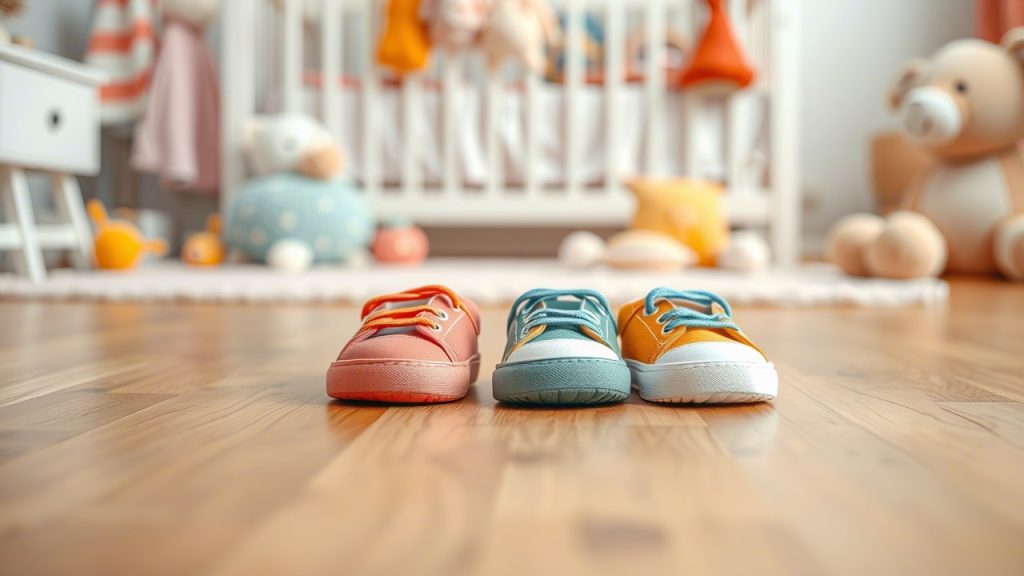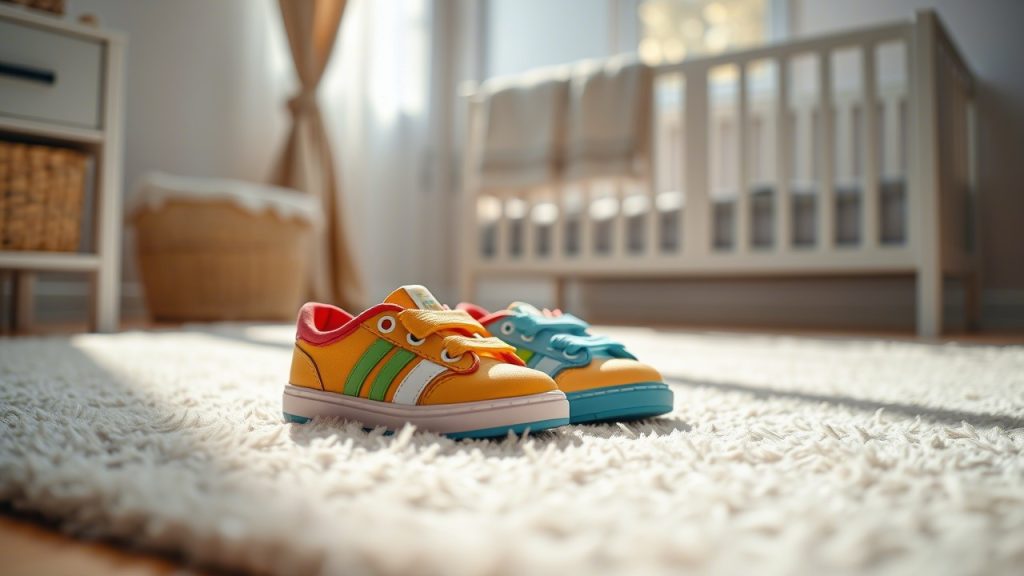Choosing the right shoes for toddlers isn’t just about picking the cutest designs or the trendiest brands. At this critical stage, a child’s foot is still developing, making it essential to provide footwear that supports healthy growth. Poorly designed shoes can lead to discomfort, improper posture, and even long-term foot issues.
We’ll dive into 10 of the best toddler shoe ideas to avoid foot pain — ensuring your little one steps into comfort, health, and happiness. Plus, we’ll answer 7 of the most common questions parents ask about toddler footwear!
Why the Right Toddler Shoes Matter
A toddler’s foot consists mostly of cartilage, not fully developed bone. The bones don’t harden completely until around age 5. That’s why their shoes must be flexible, breathable, lightweight, and supportive without being restrictive.
The wrong shoes can cause:
- Flat feet
- Knock knees
- Improper walking habits
- Long-term posture problems
- General discomfort and frequent foot pain
With that in mind, let’s get into the best choices for your toddler’s tiny toes!
10 Best Toddler Shoe Ideas to Avoid Foot Pain
1. Soft Sole Shoes for Early Walkers
For toddlers just beginning to walk (around 9–18 months), soft-soled shoes are crucial. They allow the foot to flex naturally, providing better grip and balance without limiting muscle development.
Top Pick: Robeez Soft Sole Booties
- Flexible sole
- Breathable materials
- Pediatrician-recommended
Why It’s Good: These shoes promote better foot muscle development and encourage a natural walking pattern.
2. Lightweight Sneakers
Once your toddler starts running, climbing, and exploring, you’ll need lightweight sneakers. Heavy shoes can tire them out quickly and cause awkward walking.
Top Pick: Nike Flex Runner 2 Toddlers
- Slip-on style
- Flexible sole
- Cushioned interior
Why It’s Good: The stretch-fit design supports active toddlers without constricting their feet.
3. Orthopedic Shoes for Toddlers with Special Needs
If your toddler has been diagnosed with flat feet or another orthopedic condition, specialized shoes can help. Always consult with your pediatrician or podiatrist before buying.
Top Pick: Memo Diagnostic Sandals
- Built-in arch support
- Customizable orthotic inserts
Why It’s Good: These shoes support healthy arch development and prevent further orthopedic issues.
4. Breathable Sandals for Summer
In warmer months, sweaty feet can cause discomfort and even lead to fungal infections. Breathable sandals offer protection and ventilation.
Top Pick: KEEN Newport H2 Sandals
- Water-resistant
- Closed-toe design for protection
- Machine-washable
Why It’s Good: Protects toes while allowing air to flow, keeping feet dry and comfortable.
5. Flexible Winter Boots
Cold weather shouldn’t mean heavy, rigid boots. Look for insulated yet flexible options to maintain natural foot movement.
Top Pick: Kamik Snowbug3 Boots
- Lightweight insulation
- Flexible sole
- Easy Velcro closure
Why It’s Good: Keeps tiny feet warm without limiting movement or causing foot strain.

6. Slip-Resistant Indoor Shoes
Hardwood and tile floors can be hazardous for wobbly walkers. A good pair of slip-resistant shoes can prevent falls and injuries.
Top Pick: Stride Rite Soft Motion Shoes
- Rubber soles with extra grip
- Lightweight construction
Why It’s Good: Extra grip ensures safe walking on slippery indoor surfaces.
7. Adjustable Fit Shoes
Children’s feet grow fast — sometimes a full size every few months! Shoes with adjustable straps or laces grow a bit with your child.
Top Pick: New Balance 888v2 Sneakers
- Velcro strap for easy adjustment
- Wide toe box
Why It’s Good: Provides an adaptable fit without compressing growing toes.
8. Eco-Friendly Footwear
Parents concerned about the environment and toxins often seek eco-friendly toddler shoes made from natural or recycled materials.
Top Pick: See Kai Run Stevie II
- Organic cotton lining
- Flexible rubber sole
- APMA-approved (American Podiatric Medical Association)
Why It’s Good: Safe materials and superior flexibility protect both the environment and your child’s developing feet.
9. Barefoot-Style Shoes
The barefoot movement emphasizes the natural development of muscles and coordination by mimicking walking barefoot.
Top Pick: Bobux Xplorer Go
- Super lightweight
- Thin sole for ground feel
- Unrestricted movement
Why It’s Good: Encourages healthy foot mechanics and stronger muscles.
10. Wide-Toe Box Shoes
Many mainstream shoes are too narrow for toddlers, leading to cramped toes and discomfort. A wide-toe box allows natural toe spread, which is vital for balance and stability.
Top Pick: Plae Ty Sneakers
- Customizable fit
- Extra toe room
- Durable for active toddlers
Why It’s Good: Natural foot positioning prevents pain and improves coordination.
Key Features to Look For in Toddler Shoes
When shopping, prioritize these features:
- Flexibility: Bend the sole; it should move easily.
- Breathability: Choose natural materials like leather or mesh.
- Cushioning: Light cushioning to absorb impact without over-padding.
- Secure fit: Not too tight, not too loose. The “thumb test” (a thumb’s width between toe and shoe) helps.
- Lightweight: Heavy shoes cause early fatigue and bad posture.
- Wide Toe Box: No cramped toes!

Mistakes to Avoid When Buying Toddler Shoes
- Buying shoes too big: “Growing room” sounds good, but oversized shoes can cause tripping and unnatural walking.
- Choosing hard-soled shoes too early: Soft soles are crucial for early walkers.
- Ignoring your child’s complaints: Fussiness about shoes might indicate a poor fit.
- Not checking sizes regularly: Toddlers’ feet can outgrow shoes in 2–3 months!
- Prioritizing fashion over function: Comfort and support must come first.
Frequently Asked Questions
1. How often should I replace my toddler’s shoes?
On average, every 3–4 months. Check monthly to ensure there’s enough toe space and no wear damage.
2. Is it bad for toddlers to wear hand-me-down shoes?
It can be. Worn shoes mold to the previous child’s foot and gait, potentially causing discomfort or poor walking habits in your toddler.
3. Should toddlers wear shoes indoors?
It depends. Soft, slip-resistant shoes can help prevent slips on hard floors. Barefoot is fine on carpeted, safe surfaces to promote natural muscle development.
4. Are high-top shoes better for ankle support?
Not necessarily. Healthy toddlers don’t usually need extra ankle support unless prescribed by a doctor. Flexibility is more important.
5. How can I tell if a shoe fits properly?
There should be about a thumb’s width of space between the toe and the end of the shoe, and the shoe should fit snugly at the heel without rubbing.
6. What material is best for toddler shoes?
Breathable materials like leather, canvas, and mesh are best. They allow airflow and prevent sweating and irritation.
7. What’s the best way to break in new toddler shoes?
Have your child wear them for short periods at first, gradually increasing time each day to avoid blisters or discomfort.
Final Thoughts – Choosing the Right Shoes for Happy Feet
Your toddler’s first shoes — and the next few pairs — set the foundation for their future foot health.
Always prioritize comfort, support, and flexibility over style or brand name. With the right footwear, you’ll avoid foot pain, foster proper development, and encourage your child’s confident first steps into the world.
Remember, every child’s feet are different. It’s worth taking the extra time to find the right fit to keep your little one happy, healthy, and pain-free!





